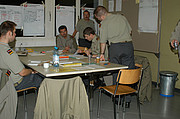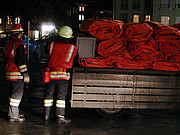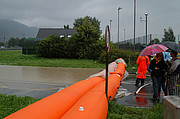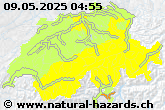In the Case of a Natural Hazard Event
The federal authorities, cantons and communes should take all possible measures to minimise the risks posed by natural hazards. However, natural disasters can never be entirely avoided. People can die and extensive material damage can arise as a result of such events. What can the authorities do when a natural hazard event occurs?

Take precautions
Natural hazard events can often be forecast in the short term; when extended periods of precipitation are expected, for example. Suitable precautions must be taken in the areas of information and alerting.
Precautionary measures that reduce the scale of natural hazard events and scope of the damage caused:
- Consistent monitoring of precipitation and discharge forecasts and snow bulletins
- Warning and timely deployment of disaster management bodies (alerting of local and cantonal authorities and, if necessary, specially created teams,five partner organisations of the civil protection system, OWARNA)
- Preparation of emergency intervention; making the necessary resources available
- Collection and evaluation of on-site observations
- Alerting and informing the population and providing instructions as to what actions people should take
- Ordering the evacuation of at-risk areas
Initiate intervention
Once a natural hazard event has occurred, it is a matter of limiting its extent with the help of the five partner organisations. These provide help in dealing with extraordinary situations (management, protection, rescue).
- Temporary protection of buildings and infrastructure: protection of buildings or areas against damage
- Sheltering, attending to and transporting of injured persons (“care teams“)
- Initiation of clearing and clean-up tasks: essential infrastructure and transport routes take priority here (i.e. lifelines: water supply, sewage disposal, electricity supply, transport routes and telecommunications)
- Organisation of weather monitoring and creation of an alarm concept (changes in the weather pose a risk to all those involved in clearance and recovery tasks)
- Supervision of emergency accommodation and food supply points
- Production of event documentation (process-event documentation and documentation of intervention by rescue teams to enable the future optimisation of further intervention)
- Reconstruction

Nation Emergency Operations Centre (NEOC)
The NEOC is the Swiss federal centre of expertise for exceptional events. It is contactable 24 hours per day, 365 days per year and its services can be mobilised within a matter of hours.
When exceptional events occur, the NEOC is the first point of contact for the cantons in all matters of civil protection. In the area of natural hazards, the NEOC formulates all of the warnings issued by the relevant offices to the management bodies of the affected cantons. In the case of serious environmental events, it also operates the federal Reporting and Situation Centre (MLZ). The NEOC provides the relevant information and forecasts to the specialist offices via a protected information platform (ELD).

FOCP
The Federal Office for Civil Protection (FOCP) supports the cantons and communes and the partner organisation in the fulfilment of their tasks in relation to civil protection. The FOCP ensures that the responsible authorities and intervention bodies are immediately alerted in the event of a disaster and that the information they require is made available to them.


